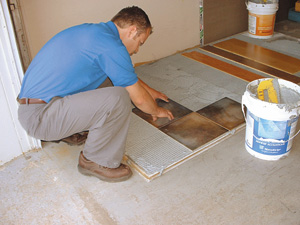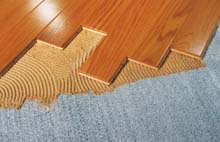Silence is Golden: Sound-Control Products for Flooring Applications


Before I describe specific types of sound-control systems for floors, I should mention some of the technical terms used in discussions of sound abatement. Among these are such terms as "STC," "IIC," "FSCT," and "FIIC."
STC is an acronym for Sound Transmission Class. It is expressed as a numerical rating that applies to airborne sounds such as those produced by the voice, radio, television, etc. IIC stands for Impact Insulation Class, which applies to impact noise transmitted by walking, furniture movement or anything dropped on the floor. The values for both STC and IIC are determined in laboratory settings.
FSTC is an acronym for Field-tested Sound Transmission Class, and FIIC stands for Field-tested Impact Insulation Class. Both, like STC and IIC, are expressions of airborne and impact sound, respectively. However, FSCT and FIIC are values gathered in a field setting.
It's important to note that all field tests yield lower values than laboratory tests do. Sound-control systems with higher ratings transmit less noise.
The need for sound-abatement systems has increased over recent years because so many occupants of multi-family residential buildings now opt for wood flooring, ceramic tile and other hard-surface products. Sound control is less of an issue when people install vinyl or carpet in their homes.

Sound control standards and systems
There are many standards, some of which pertain to sound control, set by the Uniform Building Code (UBC), International Building Code (IBC) and various municipalities. The UBC and IBC have set a sound-control design rating of 50 for multi-family structures. However, due to construction concerns associated with a field setting, the requirement is 45 for both FSTC an FIIC.As I've written previously, many - if not all - sound-abatement products are components of a total system that takes into account related characteristics such as the required thickness of the slab, insulation, acoustical ceiling tile, and so forth. An essential requirement of any such system is to block all openings - especially along the perimeter of the system where the walls and floor meet.
Various types of sound abatement products are available for flooring applications. The insulation materials they utilize also vary from cork and foam to fiberboard, poured gypsum and more.
Gypsum poured underlayments -- such as those manufactured by Hacker Industries and Maxxon Corp., to name just two suppliers -- are specified in multi-unit buildings. One firm's system utilizes a dense rubber mat as a sound-abatement component, while the other incorporates a nylon core of fused, entangled filaments.

The Silencer is an acoustical underlayment with performance properties comparable to a 1/4-inch cork product, according to its manufacturer, Calhoun, Ga.-based Foam Products Corp. The company also offers an upgraded version of the product that features an attached vapor barrier. Both can be glued, floated or nailed down.
Still another type of product, Homasote's 440 SoundBarrier, is a special-density structural board made from 100 percent recycled newspaper. Because mold has recently become a big issue in the building industries, it is worth noting that this product offers protection against termites, rot and fungi.
SonoGrip Canada manufactures an acoustic adhesive for installation of ceramic, stone tile and terrazzo. The product is formulated to serve as both a bonding agent and an acoustic barrier to impact sound transmission. SonoWood is an acoustic adhesive the company produces for the installation of engineered wood.
Another Canadian firm with an acoustical sound-control material is Acousti-Tech. Available in three thicknesses, the company's membranes are made of a non-woven composite of chosen polypropylene fibers and polyethylene. Acousti-Tech publishes data for ceramic and stone tile as well as glued-down engineered wood, 3/4-inch plank hardwood and laminate floors.
These are but a few of the systems available today. For example, Colbond Geosynthetics markets a product called Enkatherm that utilizes a nylon core of filaments. N.A.C. produces a sound-control mat that is a bitumen-modified sheet which also can serve as a crack-isolation membrane. The Noble Co. produces a chlorinated polypropylene sheet with a non-woven polyester scrim.
Other multi-component systems are available that make use of cementitious coatings with or without a fibrous mat, depending on the subfloor configuration relative to the ceiling below.
In the final analysis, your proper choice of a sound-control system depends on the situation, the cost and the warranty. Choose carefully.
More information about sound-control products may be obtained by contacting the following suppliers:
Acousti-Tech. . .(866) 889-0001
Amorin. . .(800) 255-2675
A.P.C. Cork. . .(866) 222-3241
Colbond Geosynthetics. . .(800) 365-7391
Foam Products. . .(800) 526-3626
Hacker Industries Inc.. . .(800) 642-3455
Homasote. . .(800) 257-9491
Laticrete. . .(800) 243-4788
Maxxon. . .(800) 356-7887
Midwest Padding. . .(888) 379-9695
N.A.C.. . .(800) 633-4622
Natural Cork. . .(800) 404-2675
The Noble Co.. . .(800) 878-5788
SonoGrip Canada. . .(888) 770-3434
WE Cork. . .(800) 666-2675
Looking for a reprint of this article?
From high-res PDFs to custom plaques, order your copy today!


